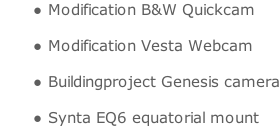



Copyright © All rights reserved. Made By Erik Bryssinck Terms of use | Privacy policy














|
Observation date |
image |
Photometry (FOCAS) |
astrometry |
Observatory |
|
|
X |
X |
|
X |
B96 - |
|
|
X |
X |
X |
X |
X02 - |
|
|
|
|
|
|
|
|
|
|
|
|
|
|
|
|
|
|
|
|
|
|
|
|
|
|
|
|
|
|
|
|
|
|
|
|
|
|
|
|
|
|
|
|
|
|
|
|
|
|
|
|
|
|
|
|
|
|
|
|
|
|
|
|
|
|
|
|
|
|
|
|
|
|
|
|
|
|
|
|
|
|
|
|
|
7P/PONS-
Photometric data obtained by use of FOCAS-
10x10 20x20 30x30 40x40 50x50 60x60 SNR SB COD
OBJECT DATE TIME +/-
-
7P 17/04/2021 01:18:40 15.71 15.22 15.02 14.86 14.84 14.89 6.1 16.4 B96
7P 17/04/2021 01:18:40* 0.11 0.18 0.11 0.20 0.31 0.37 3 3.9 Gai
7P 08/06/2021 10:22:22 14.50 13.89 13.60 13.41 13.26 13.15 20.9 19.7 X02
7P 08/06/2021 10:22:22* 0.01 0.01 0.02 0.03 0.04 0.04 3 2.9 Gai
AFRHO LOG
COMET UTC DELTA r BOX " MAG RSR CM +/-
-
7P 17/04/2021 01:18:40 0.68 1.33 40.72 14.94 6 8 1 0.914 B96
7P 08/06/2021 10:22:22 0.44 1.24 62.24 13.09 21 17 1 1.231 X02
Discovery:
Jean Louis Pons (Observatory of Marseille, France) discovered this comet on 1819 June 12 in the western sky. The comet was then in Leo and was described as small and tailless, with a central condensation with a small condensation. Pons said it was not a naked eye object, but it did brighten in the following days of his discovery. The comet was particularly well placed during its discovery apparition, but its most significant event, a close approach to Earth on 1819 August 21 (0.1318 AU) was missed. Following its discovery on June 12 the comet was followed until lost in evening twilight after July 22. The comet took on a southwestern motion thereafter, and was in southern skies by the time it emerged from the sun's glare. On August 31 it reached its most southerly declination of -
F.A.T. Winnecke (Bonn, Germany) accidently rediscovered this comet in the morning sky on 1858 march 9.06 UT, he confirmed this comet was moving when it was seen on march 9.16. Winnecke discribed it as a pale and diffuse nebolosity, about 3’ across, with n o trace of nucleus. The comet brightened slowly troughout most of march as it approached both sun and earth. The comet was near a 7-
Since the 1869 appearance, the comet has only been missed on three occasions (1880, 1904, and 1957).
Perturbations by Jupiter have steadily increased the comet's orbital period and perihelion distance since its first successfully predicted recovery in 1869. Close approaches occurred in 1882 November (0.44 AU), 1894 November (0.45 AU), 1906 December (0.42 AU), 1918 November (0.36 AU), and 1930 July (0.47 AU). In 1869 the period was 5.59 years and perihelion distance was 0.78 AU, while in 1996 they were 6.37 years and 1.26 AU.
The 1927 appearance was the best since the comet's discovery. It passed only 0.0404 AU from Earth on 1927 June 26 and attained a maximum brightness of magnitude 3.5.
For a few years the perturbations by Jupiter enabled strong displays of meteors to be seen around June 28 of the years the comet arrived at perihelion. The meteor stream became known as the June Boötids, but was occasionally also known as the Pons-
Bron: Kronk’s Cometography last updated: 2021-